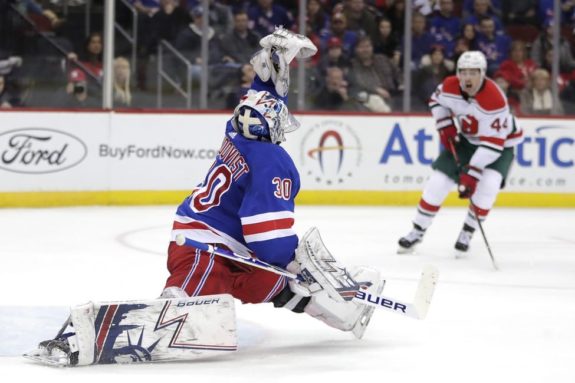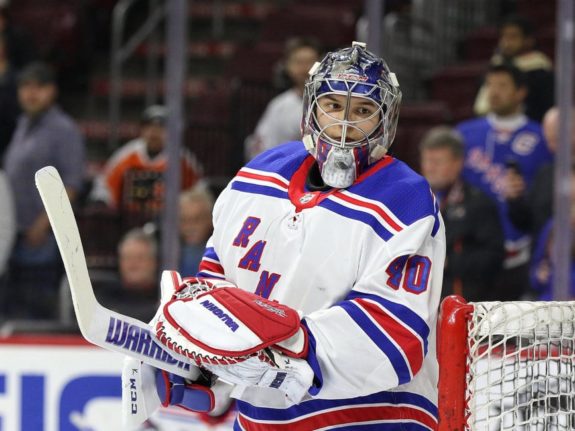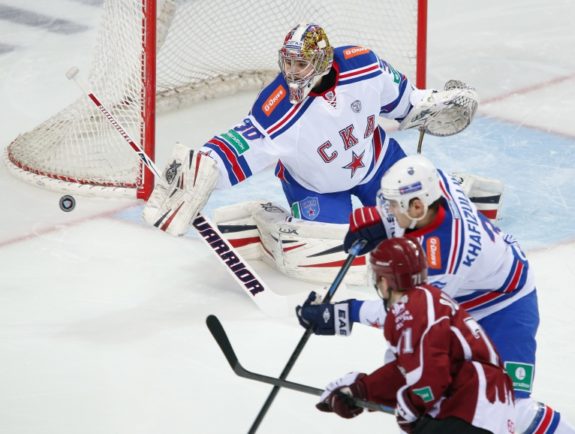As with any rebuilding effort, uncertainty and disappointment have been as much a part of the New York Rangers’ early journey back to contention as has excitement over the future.
Youngsters on the roster have experienced exhilarating highs only to fall back into bad habits and/or periods of little production later. A Baby Blueshirt looks like a future cornerstone one week and an AHL roster staple the next. Someone will respond to being scratched for lackluster play and effort with a strong stretch of games only to level off again.
Amid these roller coaster rides of players such as Tony DeAngelo, Neal Pionk, Filip Chytil and Pavel Buchnevich, there’s one area in which unbridled anticipation over the future seems warranted – ironically enough, the only one in which the Blueshirts currently boast a future Hall of Famer.
That spot is of course in goal, where Henrik Lundqvist has continued his marvelous career this season for the only team he’s ever known. Soon to be 37 years old, The King has shown he can still deliver dominance at times and remains as engaged and prepared as ever despite playing on a team that’s playing for down the road.

Yet it’s clear that Lundqvist, like almost any elite athlete in his late 30s, isn’t what he was in his late 20s. Starting three straight games from Dec. 27-31 and facing 106 shots, a clearly exhausted Lundqvist got the nod again Jan. 2 and was pounded by the Pittsburgh Penguins, allowing six goals on 18 shots before being pulled in the third period of a 7-2 loss – a situation that prompted some soul-searching from coach David Quinn.
That episode allowed the first-year coach to become fully aware of Lundqvist’s limits in his 14th season, pledging to be more careful with his workload. Yet there’s hardly panic surrounding a diminished Lundqvist within the organization because of what the Rangers have coming along behind him.
Shestyorkin, Georgiev Look Like Rangers’ Future
The beneficiary of Lundqvist’s more carefully managed schedule is 22-year-old Alexandar Georgiev, who in parts of two seasons of understudy work has shown himself to be up to the task of playing in the NHL. Extremely confident, calm and unafraid in big moments and apparently a big fan of shootouts, Georgiev has shown flashes that indicate he might prove to be more than just a solid backup in the future, whether for the Rangers or someone else.
After going 4-4-0 with a .918 save percentage (SV%) last season, the 2017 undrafted free-agent signee is 7-9-0 with a 3.24 goals-against average (GAA) and .897 SV% in 2018-19. Coming off a solid effort in Wednesday’s 4-3 shootout victory over the Boston Bruins, he’s set to continue his development by keeping Lundqvist fresh on a more regular basis for the remainder of the season.
In fact, Georgiev has shown the Rangers enough that they will probably protect him in the expansion draft in the summer of 2021 – if he’s still with the team – when Lundqvist’s seven-year contract extension will conveniently have just expired.

If Georgiev wants his Rangers future to be more than that of a backup, however, he’ll likely have to fend off a substantial challenge for the role of Lundqvist’s successor. The organization’s top prospect is Igor Shestyorkin, considered the top goaltending prospect in the NHL by some evaluators.
The Russian has continued a spectacular apprenticeship for the Rangers with another dominant season in the KHL, going 21-3-1 with a 1.20 GAA, .948 save percentage and eight shutouts for SKA St. Petersburg. He posted a goals-against average under 1.70 in each of his two KHL seasons before this one with 15 shutouts, giving him 23 and counting over the past three seasons.
Shestyorkin Ready for Move to North America
The Blueshirts have big plans for Shestyorkin, and the fourth-round pick in the 2014 Draft has made it crystal clear with his play that they can’t wait any longer than beyond this season. Shestyorkin is ready to begin acclimating to the North American game, and at age 23, can sign a two-year entry-level contract this summer.
Joining the Rangers for next season will leave him exempt for the expansion draft as a second-year player at the time of it, and the club would only be able to sign him to a one-year entry deal in the summer of 2020, when he’d be 24. He has nothing left to prove in the KHL, a formidable league.
Whether his acclimation starts in the AHL next season or he beats out Georgiev for a backup role that’s sure to give the winner significantly more work than a typical No. 2, Shestyorkin’s time is almost here. And however the Rangers choose to proceed with him in 2019-20, there has to be at least some level of comfort that the eventual departure of one of the best players in the history of the franchise can be mitigated by the elevation of a potential future star – in the best-case scenario, a nearly seamless transition from the superstar of the past to a clear No. 1 goalie of the future.

Plenty can certainly go wrong with such a perfect plan, of course. Shestyorkin needs to prove he can thrive at the highest level of hockey, while Georgiev would need to demonstrate that he can handle the pressure and workload of being a No. 1 goaltender if he earns the opportunity. It’s apparent, though, that while the Rangers remain desperate for high-end young talent throughout much of the roster, that’s hardly the case when it comes to finding the next guy in net when No. 30 eventually retires and begins the wait for his enshrinement ceremony in Toronto.